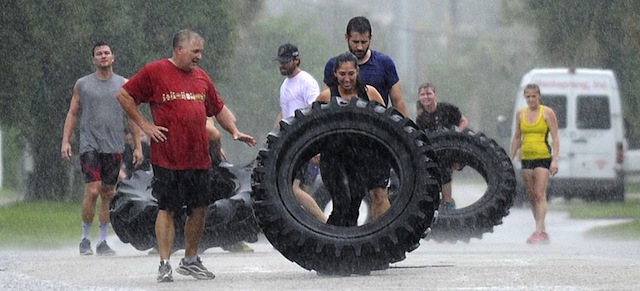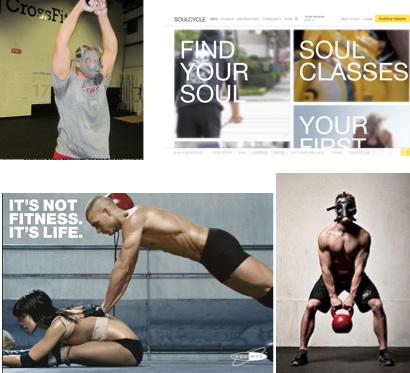
Download Audio
Venue: 2015 NYC Mockingbird Conference

COMMENTS
One response to “House of Yoga, Church of CrossFit: Filling the Spiritual Void with Exercise – Evan Brush”
Leave a Reply


Fight club isn’t about winning or losing fights. Fight club isn’t about words. […] There’s hysterical shouting in tongues like at church, and when you wake up Sunday afternoon you feel saved.
-Chuck Palahniuk, Fight Club
In an effort to fill the void, many Americans are beginning their search not in the pew but in the gym. Intense forms of exercise, from CrossFit to Boxing and Mixed Martial Arts, have grown tremendously in popularity. Some gyms attempt to directly adapt “combat sports” to a more fitness-friendly environment: “cardio kick boxing” for the stay at home dad, mitt work and sparring for the young ambitious female executive. Meanwhile, CrossFit “boxes,” CrossFiter lingo for their gyms, often revel in their Spartan simplicity: converted warehouses open and empty but for ropes, pull up bars, kettle bells, and Olympic weights.[1] Their physical spaces and advertising have a martial aesthetic indicative of toughness and camaraderie through shared pain.[2] The increasingly popular ‘Tough Mudder’ and ‘Spartan’ races similarly emulate the experience of the boot camp obstacle course. Although originally these were devised as a test of functional strength and endurance to simulate and prepare for the demands of combat, war readiness can now be distilled down to a GoPro friendly weekend fitness experience for the mere entrance fee of $230.[3]
While the cross-pollinization of ideas between the military and civilian worlds is both historically common and productive (think Jeep, Spam, GPS, etc.), the increasing dedication, what some might even call a cultivated fanaticism with which everyday workout classes simulate the rigors of military training seems to be a relatively new trend. Otherwise mild-mannered civilians draw a sense of identity, survivors’ pride and the bonds of tribalism from within these specialized subcultures.
What is not new, however, is our attempt to find release for some of man’s less palatable impulses through exercise and sport. Freud theorizes in his work Civilization and Its Discontents that many of man’s most base and aggressive desires are repressed and sublimated into other behaviors. To maintain an outwardly acceptable life, one must find outlets for those repressed desires. Robert Frost’s poem ‘Two Tramps in Mud Time’ can be read largely as a defense of the bourgeois ethic of sensibility and modest living. In it he finds such an outlet for the violent, deviant impulses of the id only through the chopping of wood, saying, “The blows that a life of self-control/ Spares to strike for the common good, / That day, giving a loose to my soul, / I spent on the unimportant wood.”
But how does the 21st century urban American, no longer consoled by the pastoral like Frost or the privileges of free time, open space, and privacy enjoyed by the Founding Fathers who could follow Thomas Jefferson’s advice–to walk one’s property for two hours each day with the weight of his gun as his ‘constant companion’–find solace? Where do the cubicle-bound find their release? Where does the Prufrock of the Facebook age blow off steam? By whittling or throwing around the baseball like his father or grandfather?
No! He does power cleans and kettle bell swings until muscle exhaustion. He hops in the ring and unleashes a stiff double jab onto the nose of that I-Banker he always sees in the elevator on weekday mornings and exclaims like Fight Club’s Tyler Durden that, “…you’re not the contents of your wallet, you’re not your f—-ing khakis!”
The faux warrior ethic is everywhere. Even endurance sports, traditional haven to the skinny former cross-country runner, are not safe from the encroachment of the martial aesthetic. When I participated in a triathlon last weekend the ‘transition area,’ where one switches from the swimming to biking phase and then from the biking to running phase, had the feeling of the staging area for an invasion force. The participants huddled at the crack of dawn, soaked and shivering under gunmetal-grey skies, and exchanged rumors of weather conditions as if we were about to storm the beaches of Normandy. We amassed in a loose formation, separated by color coded caps, numbers sharpied on arms, and computer chip inlaid anklets, decked out in the body armor of wet suits and goggles and backed by heart rate monitors, GPS watches, tear drop shaped helmets, $5,000 carbon fiber bikes, and an army of volunteers on land and water to logistically support this complex operation. As we approached the wind-battered beach, head high swells came into view tossing a Spanish Armada of police boats and surfboard-straddled lifeguards amongst the white caps. Why am I doing this to myself?
Such martial sensibilities have crept into our sports viewing habits as well. University of Virginia professor and author of the book Why Football Matters: My Education in the Game, Mark Edmundson, from whose work this post borrows heavily, asserts in his editorial for the Los Angles Times, “Football Is America’s War Game,” that while all games are on some level a sublimation of war, American football is more so. He claims the shift of America’s favorite pastime from baseball to football has coincided with American society’s post-WWII shift onto a constant war footing, noting of baseball:
You can win a baseball game without hating your opponents: In fact, too much passion will probably undermine your skills. But in football, as skilled as its players are, you had best hate your opponent, or at least simulate some hatred for the space of 60 minutes of play.
Football is urban, tough and based to a large degree on the capacity to overwhelm the other team with sheer force. Football is a tank attack, a sky-borne assault, a charge into the trenches for hand-to-hand fighting. Football is following orders and sticking to the strategy; it’s about acting as a unit and taking hits for the group. Football is generals (coaches) and captains (quarterbacks) and the enlisted guys who play on the line.
It has become apparent, to revisit the words of 4th century Roman general and author Vegetius, that those who want peace, and toned biceps, prepare for war. But what about the other psychological and spiritual needs in one’s life? What about emotions that aren’t primal aggression? What if you want to broadcast to your co-workers an identity more as a lover than a fighter?
Well, if you’re seeking spiritual fulfillment, self-actualization, love and community in a gluten-free environment, look no further, your options are multiplying! The latest trend sweeping LA and New York, epicenters of spiritual innovation, is SoulCycle. For a mere $70 to reserve a bike (it’s Manhattan after all) members can spin by candle light to customized playlists and inspirational sayings like “aspire to inspire,” “inhale intention, exhale expectation,” “be limitless,” and “think strong to be strong.”[4] Alternatively, one can find such uplifting, transformational advice at one of the hundreds of variations on yoga classes to be found throughout the city.[5]
You may be asking, where can I find all these benefits in one place while also networking with my petit bourgeoisie peers? Equinox: where “It’s Not Fitness. It’s Life.”[6] When approaching their 19th street gym (can I even call it that?), “This ruggedly chic three-story club captures the rawness of the surrounding Flatiron District, the regality of nearby Gramercy Park and the energy of neighboring Union Square. Stately white columns meld with rough metal beams to create a unique backdrop for the location’s robust class schedule and buzzing floors,” a description worthy of Seinfeld’s Elaine writing for J. Peterman. Inside and out, the building is adorned with larger than life billboards depicting young members of the meritocratic elite doing daring, sexy, athletic, trendy, exclusive looking things with the phrase “Equinox made me do it” overlaid. In the Flatiron’s only Ayn Rand approved gym, polite Lazard analysts, who work downtown but have like tonsss of friends in Williamsburg and Bushwick, transform into dynamos of self-improvement, particularly when on that last set of the day and sitting next to that JP Morgan loser who sweats about a month’s worth of Shake Shack out of his pores every time he makes it to the gym.
As Kate Hahn puts it in her hilarious piece for the New Yorker entitled, “Equinox Gym Trash Talk from Longtime Member Rachel Sherman”:
I am the best at making gym friends! I am the most dynamic, informed, experienced, educated, well-travelled but also totally relatable member of my Equinox location! When you try me with a sorry naïf like Emily Crabtree, who recently relocated from I-don’t-know-where and went to I-don’t-know-what school, that’s the result you’re going to get. Facebook-friend limit reached, ladies. Talk to me on my wall.
I am the best at intervals! Heart rate in the target zone—boom! Oxygen intake—optimized! Calories—burning! Suck it, Emily Crabtree. My Fitbit is talking about me, and what it’s saying is really positive.
So what do all these new and exciting workout trends have in common? They are Band-Aids for the parts of our soul unsatisfied, unfulfilled in the modern world. They give us a tribe, an identity in a society in which traditional tribal structures are deemed unfashionable at best and discriminatory at worst.
Most obviously, though, these trends are predicated upon the gospel of self-improvement. Athletic achievement and physical exertion has become so incredibly quantifiable that your Fitbit, Jawbone, or Apple Watch can turn your body’s feedback into something resembling the business analytics of a Fortune 500 company. Many fitness apps now post results to social media as well, adding personal fitness to the never-ending feedback loop of electronic comparison, posturing, and curating.
Where in the narrative of perpetual improvement is there room for the most human of behaviors: failure? Where is the grace afforded to us after our inevitable shortcomings? Yes, the boxing bag class can teach us hard work and sportsmanship, but can it teach compassion or to love thy neighbor? As noble as the intention in one’s practice, can yoga (the type practiced not in Tibet but Tribeca) feed the homeless?
Admittedly, after the stations of the circuit workout or the passion of the juice cleanse there is a resurrection of sorts into the newer, skinnier, healthier you. Yet these new Sadducees of the exercise world invariably ignore the fact that the continuing revelation of diet and exercise, and a community based upon improvement, are destined for both disappointment and exclusion. What about when one’s body begins to grow old? And where is the salvation for those who can’t afford the gym, who don’t know they need the gym, or, like the Emily Crabtrees of the New Yorker article, just can’t seem to get it right?
This may seem like a ridiculous comparison at first. And I must admit, I love the workout culture. I have dabbled, in a mediocre but thoroughly Instagram-documented manner, in just about every form of it under the sun. But I’ve come to realize that certain human needs, needs of the mind and soul, simply cannot be sweated out. It lacks the intellectual vigor, the selflessness, and most importantly the basis of a practice predicated on grace, forgiveness, and love that the church seeks in its best form to offer. Though not consciously, I think many of us have come to seek that same catharsis, guidance, and life anchoring presence in exercise.
In 2012, critic William Deresiewicz wrote in a New York Times piece entitled “A Matter of Taste?” that intellectual staples of western cultural have slowly been supplanted by lesser pursuits. Though connoisseurship, in Deresiewicz’ example found in foodism rather than exercise, is still used as a “vehicle of status aspiration and competition, an ever-present occasion for snobbery, one-upmanship and social aggression,” it no longer adequately addresses the intellect or the soul. Deresiewicz analyzed the change saying:
Just as aestheticism, the religion of art, inherited the position of Christianity among the progressive classes around the turn of the 20th century, so has foodism taken over from aestheticism around the turn of the 21st. Now we read the gospel according, not to Joyce or Proust, but to Michael Pollan and Alice Waters… But food, for all that, is not art. Both begin by addressing the senses, but that is where food stops. It is not narrative or representational, does not organize and express emotion. An apple is not a story, even if we can tell a story about it. A curry is not an idea, even if its creation is the result of one. Meals can evoke emotions, but only very roughly and generally, and only within a very limited range — comfort, delight, perhaps nostalgia, but not anger, say, or sorrow, or a thousand other things. Food is highly developed as a system of sensations, extremely crude as a system of symbols…A good risotto is a fine thing, but it isn’t going to give you insight into other people, allow you to see the world in a new way, or force you to take an inventory of your soul.
By no means does the church have a monopoly on philosophy, charity, or compassion, far from it. Such ideals can thrive in secular circumstances and coexist with exercise and sport. But when I bounce from gym to gym with my generation of the spiritual but not religious, I see a few people who seem to be searching for something, yearning for the fellowship, community, tradition, comfort, grace and love that the church once attempted to provide. I think our culture becomes less rich, interesting, and compassionate when the good news of the gospels is replaced with the good news of P90x. But I think we can have both if every once in a while, for every Namaste in our week, we can make room for an Amen.
[1] CrossFit, narrowly defined, consists of high intensity workouts incorporating a variety of “constantly varied, functional movements” generally combining cardiovascular fitness and strength training. CrossFit names many of it’s toughest Workouts of the Day (“WOD”) after fallen American soldiers and it’s most popular website is filled with imagery of troops deployed over seas.
[2] Many CrossFit gyms are scrawled with quotes like “Pain is weakness leaving the body” and other bromides typically reserved for Marine Corps recruiting posters. The unofficial mascot of CrossFit is Rhabdo the Clown, named after Rhabdomyolysis (the breakdown of muscle tissue that leads to the release of muscle fiber contents into the blood possibly leading to kidney damage) and pictured here: http://thenypost.files.wordpress.com/2013/09/rhabdo.jpg
[3] Really easier to explain, and believe people pay to subject themselves to this, by just checking out their website: https://toughmudder.com/
[4] http://www.nytimes.com/2014/09/14/fashion/at-soulcycle-tribeca-the-spinning-stops-panic-ensues.html?_r=0
[5] I must admit, I am extremely ignorant of the philosophical and theological underpinnings of yoga specifically and eastern thought in general but I’m pretty sure the lulu lemon clad men and women surrounding me on Monday mornings at 7 am are in a similar boat (perhaps not including the one’s with Sanskrit tattoos who waste no opportunities to throw in headstands, handstands, and Peacocks while the rest of us shake and sweat through downward dog). I’m really not sure what percentage of the class consciously goes there for spiritual reasons. For many I think it comes closer to meditation (in the most self-help-book sense of the word), relaxation, or for me exercise and stretching.
[6] As of this writing in 2014, “life” at Equinox will run you in the neighborhood of $200-300 to join and then another $205ish a month.

COMMENTS
5 responses to “House of Yoga, Church of CrossFit: Filling the Spiritual Void With Exercise”
-
On the other hand: Why yoga: Because I don’t “have to”
-
Ironic also that the most devout followers of gym religion often subscribe to the more laborious and legalistic forms of it on offer. Do more. Try harder. Humanity just loves to self-flagellate….grace applied in the gym and the kitchen does a profound work.
Leave a Reply
















[…] House of Yoga, Church of CrossFit: Filling the Spiritual Void with Exercise – Evan Brush […]